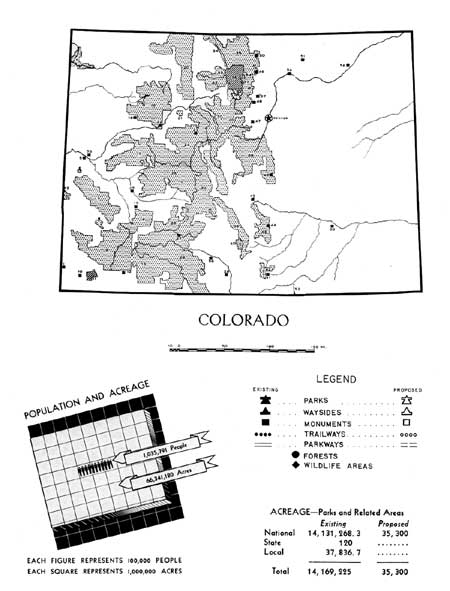|
National Park Service
A Study of the Park and Recreation Problem of the United States |

|
COLORADO
APPROXIMATELY HALF of the population is urban, most of it being concentrated at the eastern foot of the Rockies and including Denver, Fort Collins, and Greeley. The great arid plains in the east are thinly settled, and there the principal concentrations are along the railroads and the South Platte and Arkansas Rivers.
With such high-ranking recreational resources as the general high elevation, mountains, forests, dunes, archeologic remains and geologic formations, together with an exhilarating climate, Colorado is an outstanding vacation and tourist center. Agriculture, mining, and recreation are its three major industries,
Colorado contains vast areas of public lands suitable for recreation. Several of the cities have noteworthy park systems including outlying areas. Denver is the principal one, with its extensive system of mountain parks. Colorado Springs, Canyon City, and Boulder also possess large acreages. Important private recreation facilities include resorts, dude ranches, camps, and hunting and fishing areas. There are no State parks in Colorado.
The conservation of the forests, water, wildlife, and the scenic, scientific, historic, and archeologic resources is of utmost importance to the State and Nation. There is an urgent need for day-use facilities such as swimming pools, sports fields, and community centers in the eastern plains and wide mountain valleys where the climate is hot and dry and the population is sparse. The highway program might well place more emphasis on the conservation and utilization of recreational resources by roadside improvement work, provision of overlooks, and picnicking, camping, and fishing sites, and by protection against undesirable commercial developments along the highways.
There should be developed an integrated recreational program geared to the activities of Federal, State, and local public agencies, semipublic and private organizations.

(click on image for an enlargement in a new window)
| FEDERAL | ||
| National parks: | Existing acreage |
Proposed additions |
| 11. Mesa Verde | 51,333.6 | |
| 36. Rocky Mountain | 259,416.1 | 35,300 |
| Total | 310,749.7 | 35,300 |
| National monuments: | ||
| 1. Hovenweep | 125.8 | |
| 4. Dinosaur | 155,735 | |
| 5. Colorado | 18,310.9 | |
| 10. Yucca House | 10 | |
| 16. Black Canyon of the Gunnison | 13,968.5 | |
| 23. Holy Cross | 1,392 | |
| 27. Wheeler | 300 | |
| 40. Great Sand Dunes | 46,034.4 | |
| Total | 235,876.6 | |
| National forests: | ||
| 2. La Sal | 26,631 | |
| 6. Grand Mesa | 653,165 | |
| 7. Uncompahgre | 774,632 | |
| 8. Montezuma | 737,440 | |
| 13. San Juan | 1,205,230 | |
| 19. White River | 895,499 | |
| 20. Routt | 1,053,480 | |
| 21. Holy Cross | 1,085,893 | |
| 25. Gunnison | 1,282,704 | |
| 28. Rio Grande | 1,228,919 | |
| 30. Cochetopa | 1,231,199 | |
| 31. Arapaho | 961,219 | |
| 35. Roosevelt | 769,952 | |
| 38. Pike | 1,063,634 | |
| 39. San Isabel | 614,935 | |
| Total | 113,584,532 |
|
| Soil Conservation Service land development project: | ||
| 51. Weld County | 2110 | |
| State monument: | ||
| 29. Pike's Stockade | 120 | |
| STATE | ||
| Proposed parkway: | ||
| 53. Trinidad-Raton | ||
| LOCAL | ||
| Municipal parks: | ||
| 12. Durango (2 areas) | 3,770 | |
| 15. Montrose (1 area) | 600 | |
| 18. Rifle (1 area) | 454.3 | |
| 22. Glenwood Springs (2 areas) | 802.9 | |
| 41. Trinidad (1 area) | 1,327.3 | |
| 44. Pueblo (1 area) | 600 | |
| 45. Cannon City (3 area) | 6,360 | |
| 46. Colorado Springs (5 areas) | 3,557.6 | |
| 47. Denver (32 areas) | 13,472.6 | |
| 48. Boulder (1 area) | 5,275 | |
| 49. Loveland (1 area) | 720 | |
| 50. Fort Collins (2 areas) | 520 | |
| 52. Greeley (1 area) | ||
| 55. Grand Junction (1 area) | 130 | |
| 56. Monte Vista (1 area) | 37 | |
| 57. Longmont (2 areas) | 55 | |
| 58. Sterling (1 area) | 80 | |
| 59. Rocky Ford (2 areas) | 75 | |
| Total | 37,836.7 | |
1 Area under Federal administration June 1938.
2 Recreation area developed as part of large project.
| <<< Previous | <<< Contents>>> | Next >>> |
park-recreation-problem/colorado.htm
Last Updated: 18-May-2016